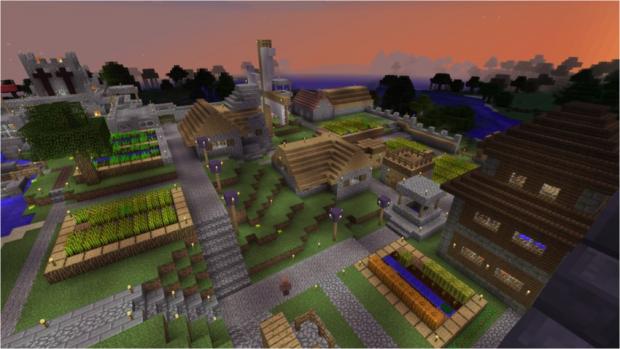First-of-its-Kind Competition for Minecraft to Probe the Creative Potential of Artificial Intelligence

Typical settlement in Minecraft, a "sand-box" style digital game in which players design and build villages, towns and cities. A team of scientists at the NYU Tandon School of Engineering's Game Innovation Lab are launching the first-ever competition for algorithms that can create adaptive settlements for the game.
BROOKLYN, New York, Wednesday, May 30,2018 – Neural networks like Google’s AlphaZero have proved that artificial intelligence (AI) can learn, play, and win complex games like Go and chess. But how is AI at free-form creativity?
A team at the NYU Tandon School of Engineering is seeking to answer this question by challenging game developers, computer scientists, and hobbyists to design algorithms that can create adaptive settlements, such as villages and cities, for Microsoft’s Minecraft, among the most popular games ever. A “sandbox,” a style of game in which minimal character limitations are placed on gamers, allowing them to roam and alter worlds at will, Minecraft is also an ideal environment in which to test the creative potential of AI.
The GDMC (Generative Design in Minecraft) Competition will allow anyone around the world – from hobbyists to computer scientists – to write an AI program that can produce a functional, aesthetically adapted settlement comparable to those designed by hand for any Minecraft map. The competition was developed at NYU’s Game Innovation lab by a team including Christoph Salge, a NYU Tandon visiting professor and the Marie Curie Global Fellow at the University of Hertfordshire, and Julian Togelius, a professor of computer science and engineering at NYU Tandon and co-director of the Game Innovation Lab.
To compete, participants must submit code that generates a settlement on several unseen Minecraft maps. The resulting settlements will be judged by a panel of experts, including game designers, urbanists, and architects, who will evaluate them based on how well they are adapted to the environment and terrain, their functionality, narrative integration, and aesthetics.
The researchers will announce the winners during the Foundations of Digital Games Conference August 7-10, 2018, in Malmo, Sweden. At that time they will also publish online the results for each algorithm, along with competition maps, the settlements, and the participants’ descriptions of their algorithms. The submission deadline is June 30, 2018.
Togelius explained that the competition addresses a relatively new area of inquiry for machine learning in games: how to develop algorithms that can design, rather than play.
“Much of my own academic career has focused on posing procedural content generation in games as a research problem,” he said. “Using AI methods to create game content initially wasn’t taken seriously as a research problem. Now it is. It is also closely tied to the related field of computational creativity, which is about AI solutions to creating things, not just winning games or solving problems. This is a new, much less explored, and, I think, a lot more exciting area of AI research.”
Togelius was part of teams that organized the only other procedural content generation competitions — one that generated levels for Super Mario and another that generated game content for the Video Game Description Language (VGDL).
Unlike Super Mario Brothers and other linear games, where it is relatively clear what goals the player tries to accomplish, Minecraft allows players to undertake the game in numerous ways.
Salge explained that the GDMC competition is unique in that it opens up a much more free-form kind of machine-generated creativity.
“Humans can do this. Children can create a world very easily, and a lot of their behavior is self-driven: a child puts together Legos and likes or doesn’t like how they look,” he said. “The challenge for an AI system that isn’t designed on a ‘win’ or ‘lose’ paradigm is in modeling the motivation, which is an area of inquiry that has been overlooked in AI.” He continued, “I want to get people to see it’s not a competition with numeral valuation, but one in which you have to figure out how to get the agent to want to do it in the first place.”
Michael Green, the NYU Tandon doctoral student who is leading the development of the competition framework, aimed to make it comparatively easy to participate by providing a downloadable software framework that can be started with just three lines of code.
“All you need to supply is the code,” said Green. “And the software is pretty easy to get started with.” He explained that this is possible because of the open and active environment around Minecraft, in which even a hobbyist can use a range of free and easily accessible tools to modify the game. This includes MCEdit, an open source software used to modify Minecraft maps, which provides the basis for the GDMC framework.
The researchers anticipate the competition will appeal to hobbyists, academics, students, modders (people who produce modifications for Minecraft using the game’s open API), and possibly even urbanists and city planners.
About the New York University Tandon School of Engineering
The NYU Tandon School of Engineering dates to 1854, the founding date for both the New York University School of Civil Engineering and Architecture and the Brooklyn Collegiate and Polytechnic Institute (widely known as Brooklyn Poly). A January 2014 merger created a comprehensive school of education and research in engineering and applied sciences, rooted in a tradition of invention and entrepreneurship and dedicated to furthering technology in service to society. In addition to its main location in Brooklyn, NYU Tandon collaborates with other schools within NYU, one of the country’s foremost private research universities, and is closely connected to engineering programs at NYU Abu Dhabi and NYU Shanghai. It operates Future Labs focused on start-up businesses in downtown Manhattan and Brooklyn and an award-winning online graduate program. For more information, visit http://engineering.nyu.edu.




